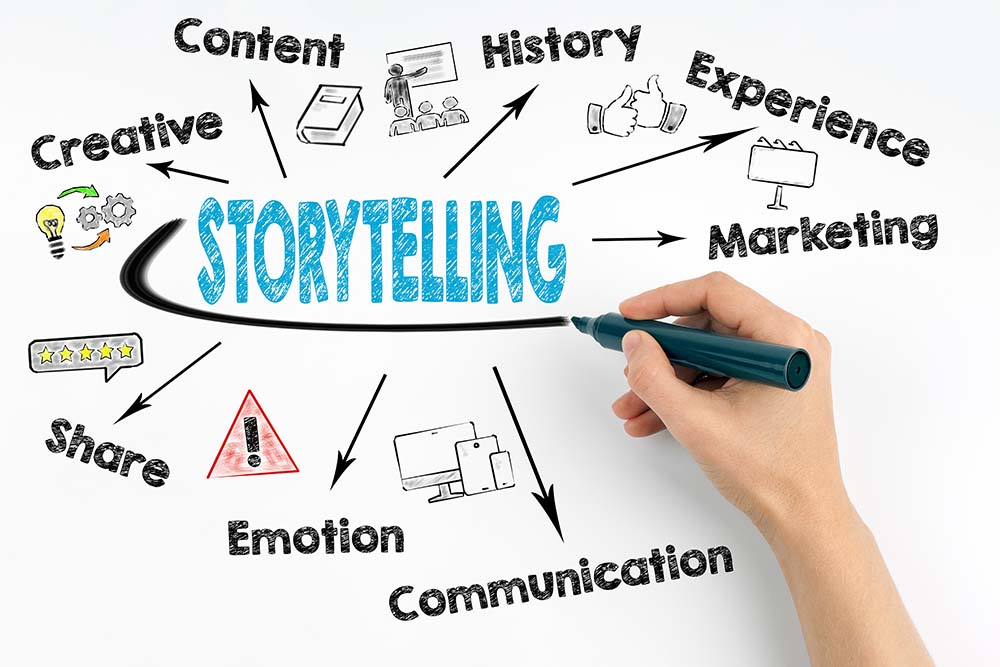In today's fast-paced world, where information is abundant, storytelling remains a timeless and invaluable skill. Whether you're a seasoned professional, a marketer or an aspiring storyteller, mastering this art can transform your ability to captivate audiences. This article aims to delve deep into the intricacies of storytelling, offering insights into its essence, the crucial qualities one must possess and actionable tactics to become a master storyteller.
Overview of Storytelling
Storytelling is the ancient and universal practice of narrating events, weaving a narrative that serves to entertain, educate, or inspire. Beyond being a mere communication tool, storytelling is a dynamic experience that leverages the emotional power of language to establish a profound connection between the storyteller and the audience. Whether conveyed through spoken words, written prose or visual elements, storytelling transcends cultural barriers, making it a powerful and effective means of communication throughout human history.
What is Storytelling?
Storytelling is a nuanced craft that extends beyond the recounting of events. It intertwines elements of plot, characters, and emotion to engage listeners or readers. Whether it's the spoken word, the written narrative, or visual storytelling, this art form has the incredible ability to transport individuals into different realms, fostering empathy, understanding and connection. At its core, storytelling is about creating a shared experience, a journey that both the storyteller and the audience embark upon together, leaving a lasting impact on both.
Qualities to Develop as a Storyteller
Becoming a proficient storyteller involves the cultivation of several key qualities, each playing a pivotal role in shaping compelling narratives.
1. Empathy
Empathy is the bedrock of impactful storytelling. A skilled storyteller must be attuned to the emotions of their audience, understanding their perspectives, and anticipating their reactions. By immersing oneself in the emotional landscape of the audience, the storyteller can create narratives that resonate deeply.
2. Authenticity
Authenticity is the cornerstone of any memorable story. It involves being true to oneself and genuine in the narrative. Authentic storytelling fosters a sense of trust and connection, as audiences are drawn to narratives that feel sincere and real.
3. Creativity
Creativity is the lifeblood of storytelling. It is the ability to think beyond conventional boundaries, crafting unique narratives that capture attention and linger in the minds of the audience. Creative storytelling stands out and leaves a lasting impression.
4. Adaptability
Adaptability is crucial in responding to diverse audiences. A skilled storyteller can adjust their approach, tone and style to suit different contexts and demographics. Adapting to the preferences of the audience ensures that the story remains engaging and relevant.
5. Observation
An effective storyteller possesses a keen observational eye, drawing inspiration from various perspectives. This quality enhances the storyteller's ability to connect with varied audiences, making stories more relatable and compelling.

Dos and Don'ts of Storytelling
Dos
1. Do Understand Your Audience: Tailor your story to resonate with the interests, values, and experiences of your audience. This fosters a stronger connection and engagement. Consider demographics, cultural nuances, and the context in which your story will be shared.
2. Do Develop Characters: Invest time in creating well-rounded characters. The depth and relatability of characters enhance the overall impact of the story, allowing the audience to connect on a personal level. Characters serve as conduits for empathy and understanding.
3. Do Master the Narrative: Structure your story with a compelling beginning, middle and end. A well-crafted narrative ensures a smooth flow and keeps the audience hooked until the conclusion. Use suspense, pacing and resolution to maintain interest. A strong narrative structure contributes to a memorable storytelling experience.
Don'ts
1. Don't Overcomplicate: Avoid unnecessary complexity. Keep your story clear and concise to prevent confusion and maintain audience interest. Clarity in storytelling is key to effective communication. Simplicity can often enhance the impact of a story.
2. Don't Neglect Emotional Connection: A story devoid of emotion lacks resonance. Ensure your narrative elicits emotional responses by incorporating relatable experiences, challenges and triumphs. Emotional engagement creates a lasting impact, fostering a deeper connection with the audience.
3. Don't Rush: Take your time to build the story. Rushed narratives can dilute the impact and fail to engage the audience effectively. Allow the story to unfold naturally, giving the audience space to absorb and connect with the narrative. Patience is a virtue in storytelling.
Storytelling Tactics: Understand Your Audience
Tailoring your storytelling to the preferences and expectations of your audience is foundational. Consider demographics, interests and cultural nuances. Understanding your audience enables you to choose themes, language, and narrative styles that resonate deeply, fostering a stronger connection and engagement. Conducting audience research and feedback analysis can provide valuable insights into what resonates with your specific audience, allowing for more targeted and impactful storytelling.
Storytelling Tactics: Develop Character
Characters serve as the heartbeat of any story. Invest time in crafting characters with depth, relatability, and clear motivations. Whether real or fictional, characters drive the narrative and create an emotional connection with the audience. Through well-developed characters, you can convey messages and themes more effectively. Develop characters with distinct personalities, backgrounds, and challenges, allowing the audience to connect emotionally and invest in the unfolding narrative.
Storytelling Tactics: Mastering the Narrative
A well-crafted narrative is akin to a symphony, with each element contributing to the overall harmony. Mastering the narrative involves creating a captivating structure, employing suspense, and ensuring a seamless flow from one plot point to the next. Effective storytelling requires careful consideration of pacing, plot twists and the overall architecture of the story. Craft a narrative that takes the audience on a journey, balancing moments of tension, revelation, and resolution to create a compelling and memorable experience.
Storytelling Tactics: Connect Your Audience Emotionally
Emotional engagement is the cornerstone of impactful storytelling. Infuse your narrative with relatable experiences, challenges and triumphs. This emotional connection transcends the story itself, forging a lasting bond between the storyteller and the audience. By evoking genuine emotions, you create a more profound and memorable storytelling experience. Utilise descriptive language, vivid imagery, and authentic emotions to immerse the audience in the story, making them active participants in the emotional journey you're weaving.
Storytelling Tactics: Demonstrating Instead of Telling
Showcasing the story through vivid descriptions, actions, and experiences enhances audience immersion. Instead of explicitly stating facts, allow the audience to infer and experience the story through sensory details and nuanced depictions. This technique not only captures attention but also encourages the audience to become active participants in the storytelling process.
Demonstrate the unfolding events and emotions through scenes and actions, inviting the audience to visualise and experience the narrative firsthand.

Conclusion
Mastering the art of storytelling is a continuous journey of refinement and exploration. By understanding the core elements, cultivating essential qualities, and employing proven tactics, you can elevate your storytelling prowess. Embrace the power of narrative, and watch as your stories resonate deeply, leaving a lasting impression on your audience. Remember, storytelling is a dynamic and evolving craft, so continue to hone your skills and experiment with different approaches to captivate diverse audiences.
To become a skilled weaver of tales, we must first grasp the threads that bind them. Character becomes the soul, pulsing with desires and flaws, guiding us through the labyrinthine paths of the narrative. Plot, the intricate map, charts the course of their journey, with twists and turns keeping us on the edge of our seats. And setting, the vibrant backdrop, paints a picture that immerses us in the world's atmosphere, be it a windswept desert or a bustling city square.
In conclusion, storytelling is a dynamic and influential art form that transcends time and culture. By honing the essential qualities and applying proven tactics, anyone can become a master storyteller. Embrace the journey, captivate your audience and let the magic of storytelling unfold in your hands.
FAQs
Can anyone become a good storyteller?
Absolutely! While natural talent can be beneficial, storytelling is a skill that can be developed with practice, observation, and a willingness to learn. Anyone with dedication and a passion for storytelling can improve their skills over time. Start by telling stories in various formats, gather feedback and continuously refine your approach.
How can I improve my storytelling for adults?
Tailor your content to adult experiences and concerns. Address complex themes and emotions, ensuring that your narrative resonates with the maturity of your audience. Consider incorporating depth, nuance and sophisticated storytelling techniques that cater to the diverse experiences and expectations of an adult audience.
Are there different storytelling styles for small storytelling?
Yes, concise and focused storytelling is essential for smaller formats. Emphasise impactful details, and ensure a clear and engaging storyline within the limited timeframe. Consider using concise language, powerful imagery and a focused narrative to make a strong impact in a shorter duration. Small storytelling requires precision, where every word contributes to the overall impact of the narrative.